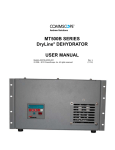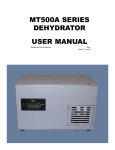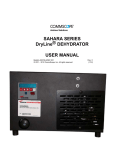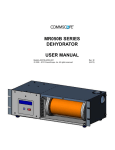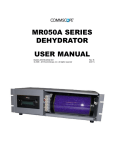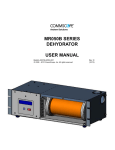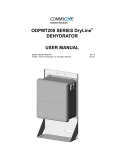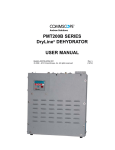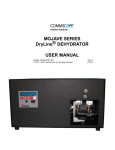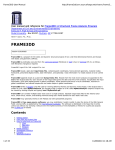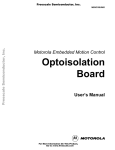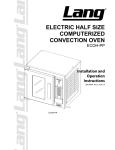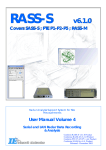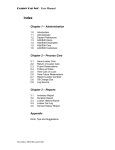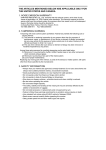Download MT050A Series Dehydrator User Manual
Transcript
MT050A SERIES DEHYDRATOR USER MANUAL Bulletin AE01B-A0527-001 © 2008 CommScope, Inc. All rights reserved. Rev: A (8/08) MT050A SERIES DEHYDRATOR USER MANUAL Table of Contents Section 1 General Information . . . . . . . . . . . . . . . . . . . . . . . . . . . . . . . . . . . . . . . . . . . . 4 1.1 Introduction . . . . . . . . . . . . . . . . . . . . . . . . . . . . . . . . . . . . . . . . . . . . . 4 1.2 Description . . . . . . . . . . . . . . . . . . . . . . . . . . . . . . . . . . . . . . . . . . . . . 4 1.3 Operation . . . . . . . . . . . . . . . . . . . . . . . . . . . . . . . . . . . . . . . . . . . . . . 4 1.4 Alarms . . . . . . . . . . . . . . . . . . . . . . . . . . . . . . . . . . . . . . . . . . . . . . . 5 1.4.1 Multiple Alarm Option . . . . . . . . . . . . . . . . . . . . . . . . . . . . . . . . . . . . . . . 5 1.5 Figure 1 Alarm Terminal Strip(s) . . . . . . . . . . . . . . . . . . . . . . . . . . . . . . . . . . . . . . . . .5 Alarm Definitions . . . . . . . . . . . . . . . . . . . . . . . . . . . . . . . . . . . . . . . . . . 5 Changing Alarm Outputs . . . . . . . . . . . . . . . . . . . . . . . . . . . . . . . . . . . . . 5 Figure 2 Alarm Board . . . . . . . . . . . . . . . . . . . . . . . . . . . . . . . . . . . . . . . . . . . . . . . .6 Specifications MT050A Dehydrator . . . . . . . . . . . . . . . . . . . . . . . . . . . . . . . . 6 Section 2 Installation . . . . . . . . . . . . . . . . . . . . . . . . . . . . . . . . . . . . . . . . . . . . . . . . . . 7 2.1 Unpacking and Inspection . . . . . . . . . . . . . . . . . . . . . . . . . . . . . . . . . . . . 7 2.2 Controls and Displays . . . . . . . . . . . . . . . . . . . . . . . . . . . . . . . . . . . . . . . 7 2.3 Installing the Dehydrator . . . . . . . . . . . . . . . . . . . . . . . . . . . . . . . . . . . . . 8 2.3.1 19” Rack Mounting or set on shelf . . . . . . . . . . . . . . . . . . . . . . . . . . . . . . . . 8 2.4 Power Connections . . . . . . . . . . . . . . . . . . . . . . . . . . . . . . . . . . . . . . . . 8 2.4.1 AC Power . . . . . . . . . . . . . . . . . . . . . . . . . . . . . . . . . . . . . . . . . . . . . 8 Test the Dehydrator . . . . . . . . . . . . . . . . . . . . . . . . . . . . . . . . . . . . . . . . 8 2.5 Connecting the Alarm Outputs . . . . . . . . . . . . . . . . . . . . . . . . . . . . . . . . . . 8 2.6 Connecting Dehydrator to the Transmission Line . . . . . . . . . . . . . . . . . . . . . . . . 8 2.7 Purging the Transmission Line . . . . . . . . . . . . . . . . . . . . . . . . . . . . . . . . . . 9 Section 3 Maintenance . . . . . . . . . . . . . . . . . . . . . . . . . . . . . . . . . . . . . . . . . . . . . . . . 10 3.0 Maintenance . . . . . . . . . . . . . . . . . . . . . . . . . . . . . . . . . . . . . . . . . . . 10 3.1 Preventive Maintenance . . . . . . . . . . . . . . . . . . . . . . . . . . . . . . . . . . . . . 10 3.2 Dehydrator Filter Element Replacement . . . . . . . . . . . . . . . . . . . . . . . . . . . . 10 3.3 Annual Inspection . . . . . . . . . . . . . . . . . . . . . . . . . . . . . . . . . . . . . . . . 10 Check the electrical connections. . . . . . . . . . . . . . . . . . . . . . . . . . . . . . . . . 11 Check the ground wire. . . . . . . . . . . . . . . . . . . . . . . . . . . . . . . . . . . . . . . 11 Check the hour meter . . . . . . . . . . . . . . . . . . . . . . . . . . . . . . . . . . . . . . . 11 3.4 Parts Replacement and Dehydrator Overhaul . . . . . . . . . . . . . . . . . . . . . . . . . . 11 Tools . . . . . . . . . . . . . . . . . . . . . . . . . . . . . . . . . . . . . . . . . . . . . . . . 11 Overhaul Procedure . . . . . . . . . . . . . . . . . . . . . . . . . . . . . . . . . . . . . . . 12 Unit Shutdown and Removal . . . . . . . . . . . . . . . . . . . . . . . . . . . . . . . . . . 12 3.5 Service Restoration . . . . . . . . . . . . . . . . . . . . . . . . . . . . . . . . . . . . . . . 12 MT050A SERIES DEHYDRATOR USER MANUAL Table of Contents continued Section 4 Troubleshooting . . . . . . . . . . . . . . . . . . . . . . . . . . . . . . . . . . . . . . . . . . . . . Section 5 Replacement Parts . . . . . . . . . . . . . . . . . . . . . . . . . . . . . . . . . . . . . . . . . . . 17 Section 6 Customer Service . . . . . . . . . . . . . . . . . . . . . . . . . . . . . . . . . . . . . . . . . . . . 17 6.0 Introduction . . . . . . . . . . . . . . . . . . . . . . . . . . . . . . . . . . . . . . . . . . . . 17 6.1 In Case of Trouble . . . . . . . . . . . . . . . . . . . . . . . . . . . . . . . . . . . . . . . . 17 6.2 Initial Steps by Andrew . . . . . . . . . . . . . . . . . . . . . . . . . . . . . . . . . . . . . 18 6.3 Return Goods Instructions . . . . . . . . . . . . . . . . . . . . . . . . . . . . . . . . . . . . 18 6.4 Repair Center Process . . . . . . . . . . . . . . . . . . . . . . . . . . . . . . . . . . . . . 18 6.5 Loaner Units . . . . . . . . . . . . . . . . . . . . . . . . . . . . . . . . . . . . . . . . . . . 18 13 SCHEMATIC WITH ALL OPTIONS (-81315) . . . . . . . . . . . . . . . . . . . . . . . . . . . . . . . 15 Low Pressure Alarm Harness (-81015) . . . . . . . . . . . . . . . . . . . . . . . . . . . . . . . . . . . 16 Warranty . . . . . . . . . . . . . . . . . . . . . . . . . . . . . . . . . . . . . . . . . . . . . . . . . . . . . . . 19 MT050A SERIES DEHYDRATOR USER MANUAL 1.3 General Information Section 1 1.1 MT050A Theory of operation. Introduction The MT050A series of DryLine® dehydrators, while similar in moisture removal technology, operates differently than some of the DryLine® series of dehydrators. In order to provide a constant supply of dry air to small air volume systems, and to maintain an acceptable dryness level in the product air stream, a high-pressure reservoir tank is utilized. This reservoir tank is connected to a pressure regulator and orifice to yield a regulated output pressure of 5.0 psi and a nominal flow rate of 0.2 SCFM. In addition to supplying the output air, the reservoir tank also provides the dry air for the feedback loop. The feedback loop is necessary to maintain the dryness of the membrane cartridge. This manual contains the information you need to install, operate and maintain your MT050A Series DryLine® dehydrator. Please take the time to read this manual before attempting to operate or service the unit. 1.2 Operation During normal operation, the bleed air in the feedback loop will cause the pressure to slowly drop in the internal reservoir tank, and the MT050A compressor will cycle automatically. These cycles will take place regardless of the system volume or condition of the transmission line the dehydrator is connected to. The rate of these cycles, however, will vary. Description MT050A Series dehydrators provide dry air for pressurizing small (up to 60 cubic feet, or 1700 liters, in volume) antenna and transmission line systems. The dehydrators produce -50ºF (-45ºC) dewpoint dry air at nominal rate of 0.2 standard cubic feet (1.4 liters) per minute (SCFM). When connected to a very tight system, or the output is capped, the dehydrator will cycle approximately every 60 minutes and maintain 5.0 psi system pressure. When open to atmosphere, the dehydrator will cycle approximately every 3 minutes while providing close to 0.2 SCFM of dry air. A typlical system will have a cycle time somewhere in between, depending on the severity of the leaks. Each dehydrator consists of an electricallydriven air compressor, a membrane dryer assembly, an automatic transmission line pressure sensing system, and alarm outputs housed in a rigid metal chassis. It is designed to mount directly to the rack or as a free-standing unit. The front panel features a control interface with display for alarms and pressure. For easy serviceability, power connections, alarm output connections, and all filter elements are accessible from the outside or through easy to access service panels. The MT050A maintains transmission line pressures at 5.0 lb/in2 (34 kPa). It is intended for standard microwave antenna applications and any other transmission line pressurization requirement that supports a medium pressure limit. The display will also reflect a pressure between 0 and 5.0 psi while the output flow is between 0 and 0.2 SCFM. The pressure sensor measures pressure beyond the flow control orifice and will show the actual pressure in the transmission lines (or to the distribution manifold). During the initial pressurization of the transmission line, the dehydrator will cycle every 2 to 4 minutes with the system at 0 psi pressure. As the dehydrator pressurizes the system, the cycle times will increase and the pressure will rise until the dehydrator output is balanced with the system leak, at which point the cycle times will stabilize. MT050A SERIES DEHYDRATOR USER MANUAL 1.4 1.4.1 Alarms Alarm Definitions: The MT050A offers Low Pressure and Excess Run alarms as a standard feature. Alarm conditions are indicated on the display. Alarms are output as a common summary alarm, with a form C dry contact. The alarm is set for continuity on alarm. Power Fail: Activates open when power is removed from the dehydrator. This includes turning the power off at the switch. High Humidity: Activates when system or dehydrator output humidity rise above 7.5% relative humidity. At initial installation, this alarm will continue to alarm until the system has been properly purged. Excess Run: Factory strapped run time set in accordance with the normal run time for the dehydrator application. Selectable times are 10, 30, 120 and 240 minutes, with the 10 minute selection used on the MT050A. Low Pressure: If system pressure falls below the low-pressure trigger point, the lowpressure alarm sensor will activate an alarm contact. This alarm is an indication of a significant system leak or a dehydrator failure. Multiple Alarm Option This optional assembly is designed to provide the additional High Humidity alarm to Andrew Dehydrators. All alarms are Form C dry contacts and are factory set for continuity at alarm (mains power fail alarm opens at alarm). This optional assembly will also indicate discrete alarms on the display, and provide individual contacts and connections for discrete alarms. The external alarm monitoring system (supplied by others) is connected to the terminal strip located on the rear of the cabinet. A small slotted screwdriver is necessary to make the connections. The connection to the alarm strip is as follows, refer to Figure 1 for correct locations and colors of the wires on the terminal strip. Changing Alarm Outputs: Alarm Factory setting Where To Reset Summary Alarm Normally Open (N.O.) TB3 on Control Board Multiple Alarms Figure 1 Term. 1 2 3 4 5 6 7 8 Function Power Fail Com Power Fail Alarm Humidity Com Humidity Alarm Excess Run Com Excess Run Alarm Low Press. Com. Low Press. Alarm Wire Color Black Red Green Brown Blue White Gray Orange Alarm Factory setting Where To Reset Low Pressure Mains (Power) Normally Open (N.O.) A-B Normally Closed (N.C.) B-C Low Pressure jumper JP4 on alarm PCB Excess Run Normally Open (N.O.) A-B Jumper JP1 on Run Alarm PCB High Humidity Normally Open (N.O.) A-B Jumper JP2 on Alarm PCB Power Fail Jumper JP3 on Alarm PCB MT050A SERIES DEHYDRATOR USER MANUAL J2 Press. Switch PS2 J4 Humidity Sensor J5 Main Power JP2 Power Selector Input AC - (A-B) DC - (B-C) JP1 Compressor Excess Alarm Timer (10 min.) J3 Timer Connection JP3 Compressor Voltage Timer Set (120v) JP4 Aux (A-B) N.O. J1 Press. Switch PS1 FUSE 5 amp, 250V Figure 2 1.5 Specifications MT050A Dehydrator Output Pressure Constant 5.0 PSI (35kPa) Output capacity 12.0 SCFH (340liters/h) (total, approx.) 0.12 SCFM (3.4 liters/m) Output Dew Point, -50°F (-45°C) or better Operating Temperature Range 33° to +104° F (1° to +40° C) Low Pressure Alarm 1.0 lb/in2 (6.9 kPa) Electrical Input 115/230 Vac, 50/60 Hz (auto switching) Output Connector 3/8” polytube, compression Dimensions 17” W x 7” H x 17” D 432mm H x 178mm W x 432mm D Weight 36 1/2 lbs 16.55 kg Optional Alarms High Humidity Alarm Set Point 7.5% RH, factory set Excess Run Alarm Set Point 10 minutes, factory set Power Fail Alarm loss of input power MT050A SERIES DEHYDRATOR USER MANUAL Installation Section 2 2.1 Unpacking and Inspection Open carton. Mode 1: Displays pressure and total run hours. Mode 2: Displays pressure and total run hours, flashes current condition. Mode 3: Displays last ON and last OFF times. Remove the top piece of closed-cell foam packaging. Carefully remove the installation accessories and manual and dehydrator. Check the dehydrator for shipping damage such as dents or loose parts. 2.2 Controls and Displays Familiarize yourself with the controls and displays prior to installing or testing the dehydrator. ON/OFF Switch MODE Switch ON/OFF SwitchToggles unit condition ON and OFF. Mode Switch Toggles between display modes. MT050A SERIES DEHYDRATOR USER MANUAL 2.3 Installing the Dehydrator 2.3.1 19” Rack Mounting or set on shelf 2.4 Power Connections Test the Dehydrator Turn the dehydrator ON and check the output port on the rear of the unit to make sure air is flowing. Confirm your dehydrator electrical input matches the available power. 2.5 To connect the alarms, locate the terminal block (TB-1) on the rear of the unit. 115 Vac/230 Vac, 50/60 Hz (auto switching) MT050A-81015 MT050A-81315 24/48 Vdc options are available with appropriate inverter kit 2.4.1 Connecting the Alarm Outputs AC Power AC units can be connected into a standard 15 Amp power receptacle of the proper voltage. Make sure the power circuit is properly grounded. Two power cords are supplied, one 115 Vac American and one 230 Vac International. Place alarm connection wires in proper terminals and tighten the screw on the terminal block. The relay contacts are rated at 2 A (noninductive), 30 Vdc. Optional alarms (if purchased) will also be located on this terminal (see section 1.4 for terminal numbers). CAUTION: Proper electrical connection is required. It is suggested a licensed electrician be contracted to connect the AC wiring to the unit, if it is connected directly to the mains. Failure to properly connect the power wires could result in a dangerous electrical shock hazard. 2.6 Connecting Dehydrator to the Transmission Line CAUTION: Check the antenna and transmission line system pressure rating before connecting the dehydrator to the system. Insert one end of the 3/8” polytube feed line tubing into the compression fitting on the dehydrator output port. Tighten securely with a 9/16” wrench. Be careful not to over tighten. Connect the other end of the polytube to the transmission line. MT050A SERIES DEHYDRATOR USER MANUAL Note: If the transmission lines have not been purged, continue with section 2.7. Otherwise proceed to section 3. 2.7 Purging the Transmission Line Air in the transmission line system must be replaced with dry air to ensure satisfactory operation of the transmitted signal. 1. Determine the total system volume. 2. Divide the system volume by the flow rate of the dehydrator (12 CFH) to determine the number of hours needed for the purge cycle. 3. Open the far end of the transmission line. 4. Operate the dehydrator for three purge cycles. If it is not possible to open the far end of the transmission line, follow these steps: 1. Connect the dehydrator to the transmission line and pressurize the system. The system pressure should reach 5.0 PSI. 2. Wait 15 minutes while the air absorbs moisture in the system, then disconnect the dehydrator from the transmission line and allow the air to vent. 3. Repeat steps 1 and 2 twelve times to purge the system. MT050A SERIES DEHYDRATOR USER MANUAL CAUTION: Do not apply oil or other chemicals to the filter element. Maintenance Section 3 3.0 Maintenance Make sure the element is seated completely in the housing and then replace the cover. Discard the old element. The MT050A Dehydrator requires relatively little maintenance to ensure satisfactory operation over long periods of time. This section outlines the recommended annual preventive maintenance for the unit and the suggested overhaul for every 6000 hours of compressor operation. 3.1 3.3 Warning: Electrical Hazard! Unplug power cord before servicing unit. Preventive Maintenance Inspection includes checking for loose or damaged hoses, fittings and electrical connections. Open the top cover and front door and verify that there is no water build-up in the two filter bowls located inside the front cover of the dehydrator. There may be some droplets of water in the filter bowels (the lower portion of each bowl), but there should be only a small amount of liquid in either bowl. The annual maintenance of a MT050A consists of a preventative maintenance inspection of the dehydrator and cleaning (or replacement) of the foam air intake filter. These tasks can easily be performed in the field with the unit connected to the transmission line system and with only the front and side access doors opened for maintenance. In addition to the annual inspection, a complete overhaul is recommended every 6000 hours or sooner if local conditions warrant. 3.2 Annual Inspection Dehydrator Filter Element Replacement Clean/replace the air intake filter The air intake filter protects the compressor from contamination and dust. Periodic replacement extends the life of the compressor. To gain access to the element, push in on the cover and rotate the house approximately 1/4 turn CCW.. The filter is made of a fibrous material. It should be replaced once a year (or more frequently, if the operating environment is very dusty.) 10 MT050A SERIES DEHYDRATOR USER MANUAL Check the hour meter Check the hour meter on the front panel to determine the duty cycle of the dehydrator. If the dehydrator has been running for more than 20% of its installed time, check the systems for leaks. Also check the time on the meter to determine if it is time to perform the 6000-hour overhaul. 3.4 Parts Replacement and Dehydrator Overhaul Andrew MT050A Dehydrators are designed to give many years of trouble-free service and require very minimal maintenance. The dehydrator contains, as a standard feature, an hour meter that records compressor run hours. To ensure continuous and reliable operation, the dehydrator must be overhauled every 6000 hours of compressor operation. The kits, shown in Section 5, contain all of the necessary parts to perform this overhaul. The dehydrator overhaul kit includes parts to overhaul the compressor and critical components in the dehydrator that often become worn over time. If there is excessive water, refer to the troubleshooting section. Replacement of the filter elements in the water filter and coalescing filter is covered in the overhaul section of this manual. Check the electrical connections. Check the screw at the power input connector to ensure that the AC power cord is securely terminated. Check the screw-in alarm terminals to ensure that all wire connections are tight. IN CASE OF DIFFICULTY: If the dehydrator is not operating, refer to Section 2 on Installation and Section 4 on Troubleshooting the unit. A loose or damaged connection may result in erratic operation and unnecessary downtime. Refer to the troubleshooting section if an electrical problem is encountered. Tools Check the ground wire. The following tools are used in the maintenance and overhaul procedures. Check that an electrical safety ground is installed on the stud on the rear of the dehydrator. This connection point is to adjacent the power input connector. (It is intended to be customer installed in the field.) 11 Adjustable open-end wrench Allen wrench 5/32 #2 Phillips screwdriver Small flat-blade screw-driver MT050A SERIES DEHYDRATOR USER MANUAL Overhaul Procedure When the MT050A compressor run time reaches 6000 hours (or a multiple of 6000 hours) it is time to replace certain items in the compressor and the air path of the dehydrator. These include the piston cups, piston seals and head gaskets of the compressor, the filter elements in the water and coalescing filters, and the tube section connecting the compressor output to the water filter input. Unit Shutdown and Removal Follow the instructions included in the compressor overhaul kit. When the overhaul is complete, reinstall. In order to perform an overhaul on the MT050A, the unit must be turned off and removed from service. As this is being done, the low pressure alarm may activate through a reporting alarm system. Personnel monitoring such an alarm should be notified in advance so that they are aware of the fact that service is being performed. It is also necessary to disconnect the dehydrator dry air output from the waveguide system during the overhaul. 3.5 RECOMMENDATION: If the dehydrator overhaul process has taken more than a few hours, it is recommended that the unit be run for one hour into the room, to purge the membrane dryer and tank of any acquired moisture, before reconnecting to the transmission line system. Remove the chassis top and side panels for overhaul. 1. Unplug the unit from the power supply. 2 Follow the instructions included in the compressor overhaul kit. When the overhaul is complete, reinstall. Complete overhaul can be done without removing the compressor from the chassis. The compressor head, air filter, output port and relief valve can all be removed though side panel. Service Restoration 12 MT050A SERIES DEHYDRATOR USER MANUAL Troubleshooting Section 4 If you experience difficulty with your dehydrator, use the troubleshooting procedures described below. Caution:Electrical troubleshooting requires access to potentially dangerous voltages and should only be performed by a licensed electrician. Problem/Condition Solution If the display light fails to light, make sure the unit is plugged in and power outlet is operating. Dehydrator display does not light, unit does not run. If you still have no light, unplug the unit, remove the unit cover and check for loose connections. Refer to the wiring diagram for proper connections. Check to assure that the fuse is OK. Check to assure that proper AC voltage is being supplied to the input. Plug the unit output with finger and observe pressure gauge. The pressure gauge line should read approximately 5.0 psi and the alarm should clear. If alarm does not clear, remove cover and verify tubing and wiring connections are secure. Low-pressure alarm activated. If the pressure does not remain constant after plugging the output, apply leak detector to isolate the leak in the dehydrator (exercise care when applying solution not to wet wiring or electronics). With dehydrator isolated from transmission line, observe pressure in transmission line. If pressure drops, use a leak detector solution to locate leaks in the transmission line. Repair leaks if possible. If the problem persists contact Andrew Customer Service. Compressor does not turn OFF. Check the display on the controller. Toggle the ON/OFF switch (left of the display). Check input power polarity and voltage per wiring diagram. Filter bowls show excessive water. Ensure that the drain line tubing (exiting the bottom of the unit) is not clogged. When the compressor cycles off, air and moisture should flow out of the drain line (into drain pan). 13 MT050A SERIES DEHYDRATOR USER MANUAL NOTES: 14 15 ORANGE GRAY WHITE BLUE BROWN GREEN RED BLACK GREEN EMPTYSLOT J3 TB4 TB3 J1 J4 RED BLACK TB1 WHITE BLACK BLACK WHITE GREEN/ YELLOW GROUND BLACK WHITE WHITE GREEN/YELLOW SCHEMATIC WITH ALL OPTIONS (-81315) J2 TB2 BLACK GREEN/YELLOW WHITE BLACK SV1 MT050A SERIES DEHYDRATOR USER MANUAL Low Pressure Alarm Harness (-81015) MT050A SERIES DEHYDRATOR USER MANUAL 16 MT050A SERIES DEHYDRATOR USER MANUAL Replacement Parts Section 5 Customer Service Section 6 The following is a list of the replacement kits for the MT050A Series dehydrators: Check website for latest updates to manual and parts list. 6.0 Introduction Andrew provides in-warranty and out-of-warranty repairs as well as dehydrator and compressor overhauls from several Repair Centers. Coordination of these services is provided through the nearest Sales Office or Customer Service Center. The Center is also prepared to help you with the following: Overhaul Kit MT050A-KIT-OVRHL 6.1 Technical Assistance Troubleshooting Repairs Loaner Units Spare Parts Installation Materials System Accessories. In Case of Trouble The first step you should take if trouble develops using a dehydrator is to read the operators manual and follow the trouble isolating procedures given in it. Filter Element Replacement Kit MT050A-KIT-ELMNT If the steps in the manual do not identify and remedy the problem, then contact an Andrew Customer Service Center for 24-hour telephone assistance. Record the Model Number (e.g. MT050A) and Serial Number from the product label, as you will be asked for these when you call. Two main locations are currently available to help: Filter Bowl Assemble Replacement Kit MT050A-KIT-FLTRS in North America Telephone: 1-800-255-1479 Fax (U.S.A.): 1-800-349-5444 in Europe Telephone: +44 1592 782612 Fax Number: +44 1592 782380 Filter Bowl Assemble and Dryer Tube Replacement Kit MT050A-KIT-DRYER International Telephone: +1-779-435-6500 Fax Number: +1-779-435-8579 Web Access Internet: www.commscope.com Email: #[email protected] Solenoid Replacement Kit MT050A-KIT-SOLND 17 MT050A SERIES DEHYDRATOR USER MANUAL 6.2 Initial Steps by Andrew If you have saved the original packaging that came with the unit, use it to return the dehydrator for repair. If a loaner unit (of the same type) was supplied by Andrew, use the loaner unit box to return the original dehydrator. When your call or fax communication is received, the Andrew staff will work with you to pinpoint the possible cause of trouble. If the pressurization equipment is suspect, they will: 6.3 * ask for your unit Model Number and Serial Number * check the warranty status of the unit * advise the availability of a loaner unit * provide of the cost for inspection and repairs, if the unit is out-of-warranty * fax a Return Goods Authorization Sheet to you. 6.4 The Andrew Dehydrator Repair Center will receive your unit and inspect it for any transport damage. The unit will then be analyzed for troubles using the description you have supplied and the specialized experience the Repair Center staff have with dehydrators. If the unit is in-warranty, repairs are made at no charge and the unit will be returned to you by the same mode of transport as it was received. If the unit is in-warranty, but no problems are found, the unit will be thoroughly tested before being returned to you. A nominal inspection fee will be charged for this service. Return Goods Instructions After you have contacted Andrew and received a Return Goods Authorization Number (RGN), you will need to take the following steps to send the faulty unit to a Repair Center: * If your unit is out-of-warranty, it will be inspected and repaired for the quoted fee. 6.5 make a copy of the Return Goods Authorization Sheet that was faxed to you * write a brief description of the trouble you are encountering and attach this to the copy of the sheet * pack the unit (with at least 4-inches of protective packaging on all sides) * enclose the authorization sheet and trouble description within the box * enclose a purchase order or other method of payment for non warranty repairs. * mark the outside of the box with the RGN * return the box to the Repair Center address listed on the authorization sheet. Repair Center Process Loaner Units The Andrew dehydrator Repair Centers stock a limited number of “loaner” dehydrator units of both current and discontinued products. These units, while not new, are still in excellent working order. Loaners are available on a first-come firstserved basis. They are issued in conjunction with the original RGN and are invoiced at a nominal price. You will need to request a second RGN to return the loaner unit. A credit memo is issued by the Repair Center when a loaner is returned 18 MT050A SERIES DEHYDRATOR USER MANUAL 19 MT050A SERIES DEHYDRATOR USER MANUAL This page was left blank. 20





















